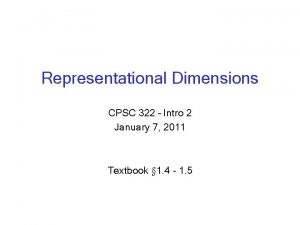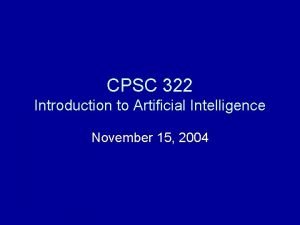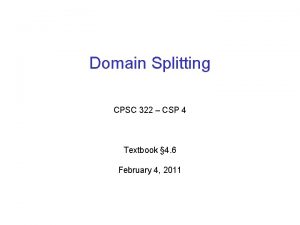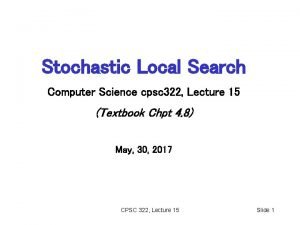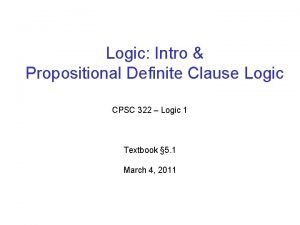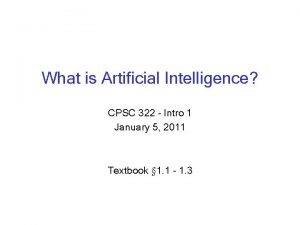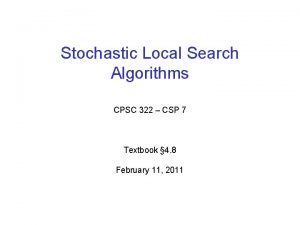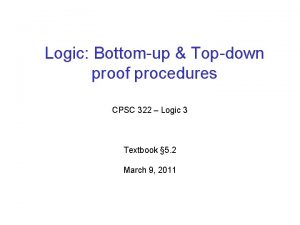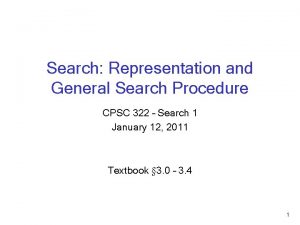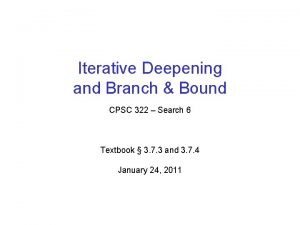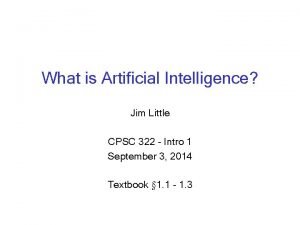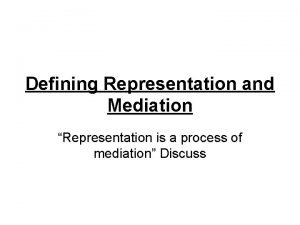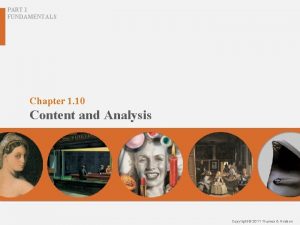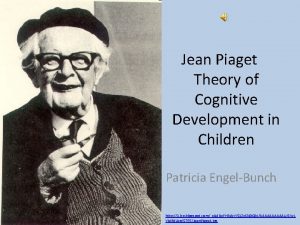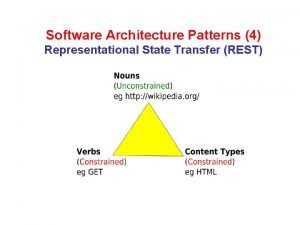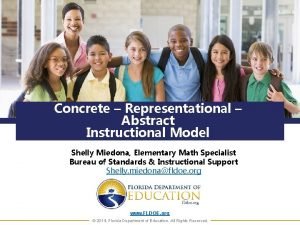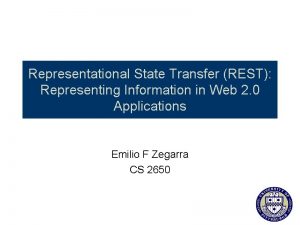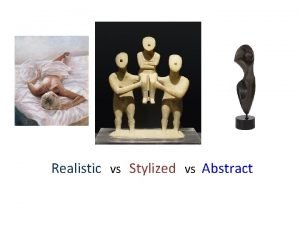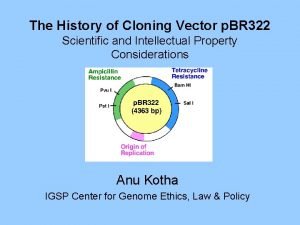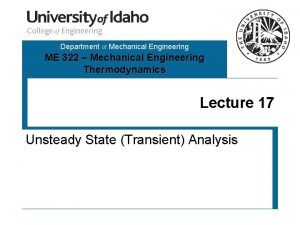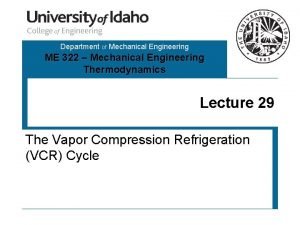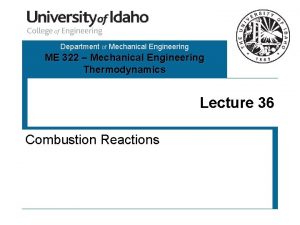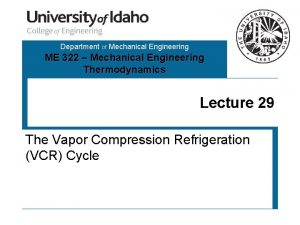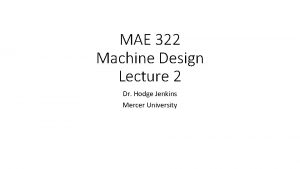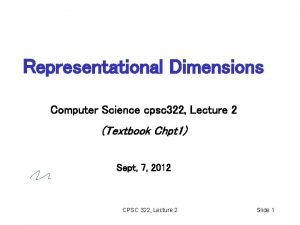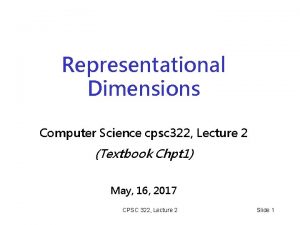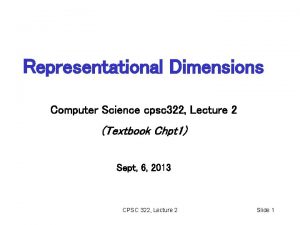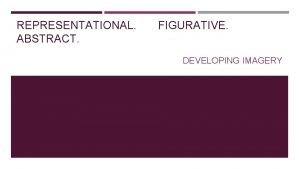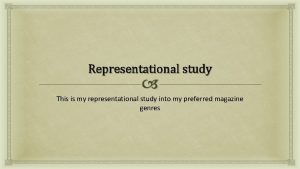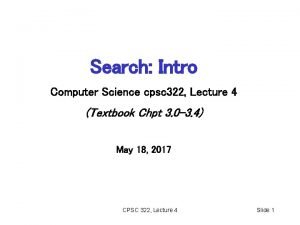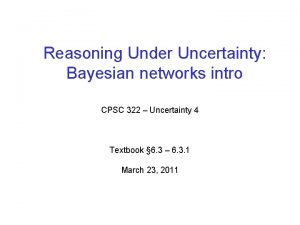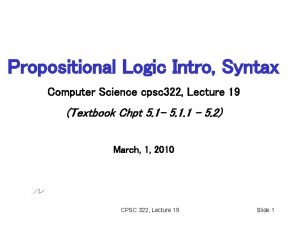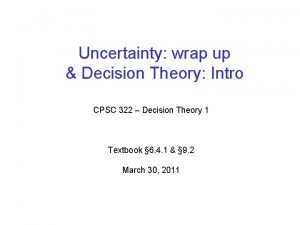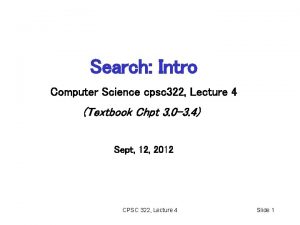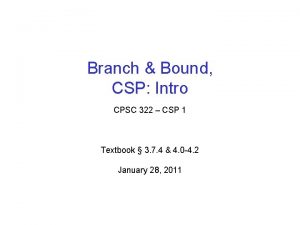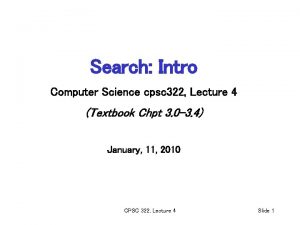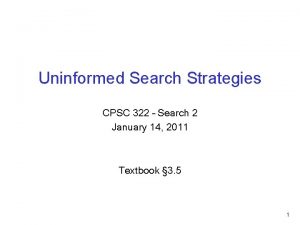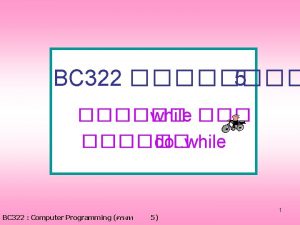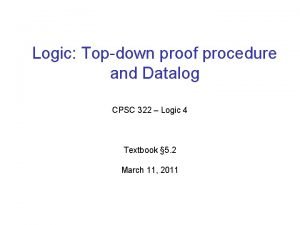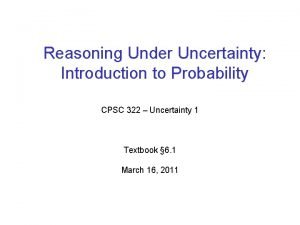Representational Dimensions CPSC 322 Intro 2 January 7

































- Slides: 33

Representational Dimensions CPSC 322 – Intro 2 January 7, 2011 Textbook § 1. 4 - 1. 5

Colored Cards • Please come to the front and pick up – 4 index cards – 2 Post-it per colour (Blue, Yellow, Green, Pink) • Use this material to make 4 “voting cards” as below – Low budget variant of clickers • Please bring them to class every time 2

Today’s Lecture • Recap from last lecture • Representation and Reasoning • An Overview of This Course • Further Representational Dimensions 3

Teaching team & office hours • Instructor – Frank Hutter (hutter@cs. ubc. ca; Beta lab, ICICS X 560) • Monday, Wednesday, Friday, 4 -4: 30 pm in ICICS X 530 • TAs – All office hours in the Demco Learning Center: ICICS X 150 (behind Reboot Cafe) – Simona Radu (sradu@cs. ubc. ca) • Monday, 11 am-12 pm. – Vasanth Rajendran (vasanthr@cs. ubc. ca) • Thursday, 3 pm-4 pm – Mike Chiang (mchc@cs. ubc. ca) • Wed 1 - 2 pm 4

Course Essentials • Website: http: //www. ugrad. cs. ubc. ca/~cs 322 • Main Textbook – Artificial Intelligence: Foundations of Computational Agents. By Poole and Mackworth. (P&M) – Available electronically (free) http: //artint. info/html/Art. Int. html – We will cover Chapters: 1, 3, 4, 5, 6, 8, 9 • Web. CT – – – Assignments posted there Practice exercises (ungraded) Learning goals Discussion board Check it often 5

What is Artificial Intelligence? • We use the following definition Systems that think rationally Systems that act like humans Systems that act rationally Systems that think like humans 6

Intelligent Agents in the World Knowledge Representation Machine Learning abilities Reasoning + Decision Theory Natural Language Generation Natural Language Understanding + Computer Vision Speech Recognition + Physiological Sensing Mining of Interaction Logs + Robotics + Human Computer /Robot Interaction 7

Today’s Lecture • Recap from last lecture • Representation and Reasoning • An Overview of This Course • Further Representational Dimensions 8

Representation and Reasoning To use these inputs an agent needs to represent them Þ knowledge One of AI goals: specify how a system can • Acquire and represent knowledge about a domain (representation) • Use the knowledge to solve problems in that domain (reasoning)

Representation and Reasoning (R&R) System Problem � representation � computation • A representation language that allows to describe – The environment and – Problems (questions/tasks) to be solved • Computational reasoning procedures to – Compute a solution to a problem – E. g. , an answer/sequence of actions • Choice of an appropriate R&R system depends on – Various properties of the environment, the agent, the computational resources, the type of problems, etc 10

What do we want from a representation? We want a representation to be: – rich enough to express the knowledge needed to solve the problem – as close to the problem as possible: compact, natural and maintainable – amenable to efficient computation; able to express features of the problem we can exploit for computational gain – learnable from data and past experiences – able to trade of accuracy and computation time 11

We want a representation for a problem to be… … as general as possible … as close to the problem as possible 12

Today’s Lecture • Recap from last lecture • Representation and Reasoning • An Overview of This Course • Further Representational Dimensions 13

High-level overview of this course This course will emphasize two main themes: • Reasoning – How should an agent act given the current state of its environment and its goals? • Representation – How should the environment be represented in order to help an agent to reason effectively? 14

Main Representational Dimensions Considered Domains can be classified by the following dimensions: • 1. Uncertainty – Deterministic vs. stochastic domains • 2. How many actions does the agent need to perform? – Static vs. sequential domains An important design choice is: • 3. Representation scheme – Explicit states vs. propositions vs. relations 15

1. Deterministic vs. Stochastic Domains Historically, AI has been divided into two camps: – those who prefer representations based on logic – those who prefer probability • Is the agent's knowledge certain or uncertain? – Poker vs. chess • Is the environment deterministic or stochastic? – Is the outcome of an action certain? E. g. slippage in a robot • Some of the most exciting current research in AI is actually building bridges between these camps 16

2. Static vs. Sequential Domains How many actions does the agent need to select? • The agent needs to take a single action – solve a Sudoku – diagnose a patient with a disease • The agent needs to take a sequence of actions – navigate through an environment to reach a goal state – bid in online auctions to purchase a desired good – decide sequence of tests to enable a better diagnosis of the patient Caveat: • Distinction between the two can be a bit artificial – In deterministic domains, we can redefine actions (e. g. , fill in individual numbers in the Sudoku vs. solving the whole thing) – Not in stochastic domains 17

3. Explicit State vs. Features How do we model the environment? • You can enumerate the possible states of the world • A state can be described in terms of features – Often the more natural description – 30 binary features can represent 230 =1, 073, 741, 824 states 18

3. Explicit State vs. Features (cont’d) Mars Explorer Example {S, C} Weather Temperature [-40, 40] Longitude [0, 359] Latitude [0, 179] One possible state {S, -30, 320, 110} Number of possible states (mutually exclusive) 2 x 81 x 360 x 180

3. Explicit State vs. Features vs. Relations • States can be described in terms of objects and relationships • There is a proposition for each relationship on each tuple of objects • University Example: – Students (S) = {s 1, s 2, s 3, …, s 200) – Courses (C) = {c 1, c 2, c 3, …, c 10} – Registered (S, C) – Number of Relations: 1 – Number of Propositions: 200*10 200+10 10200 20010 20

3. Explicit State vs. Features vs. Relations • States can be described in terms of objects and relationships • There is a proposition for each relationship on each tuple of objects • University Example: – Students (S) = {s 1, s 2, s 3, …, s 200) – Courses (C) = {c 1, c 2, c 3, …, c 10} – Registered (S, C) – Number of Relations: 1 – Number of Propositions: 200*10 = 2000 – Number of States: 2000*2 2000+2 20002 22000 21

Course Map Dimen- Deterministic sions vs. Course Stochastic Static vs. Sequential States vs. Features vs. Relations 1. Search Deterministic States 2. CSPs Deterministic Static Features 3. Planning Deterministic Sequential States or Features 4. Logic Deterministic Static Relations 5. Uncertainty Stochastic Static Features 6. Decision Theory Sequential Features Modules Stochastic 22

Example reasoning tasks for delivery robot Dimen- Deterministic Static sions vs. Course Stochastic Sequential Modules States vs. Features vs. Relations 1. Search Deterministic States “find path in known map” 2. CSPs Deterministic Static Features “are deliveries feasible? ” 3. Planning Deterministic Sequential States or Features “what order to do things in to finish jobs fastest? ” 4. Logic Deterministic Static Relations 5. Uncertainty Stochastic Static Features “probability of slipping” 6. Decision Theory Stochastic Sequential Features “given that I may slip and the utilities of being late and of crashing, should I 23 take a detour? ” “Has. Coffee(Person) if In. Room(Person, Room) Delivered. Coffee(Room)”

Today’s Lecture • Recap from last lecture • Representation and Reasoning • An Overview of This Course • Further Representational Dimensions 24

Further Dimensions of Representational Complexity We've already discussed: 1. Deterministic versus stochastic domains 2. Static vs. Sequential domains 3. Explicit state or features or relations Some other important dimensions of complexity: 4. Flat vs. hierarchical representation 5. Knowledge given vs. knowledge learned from experience 6. Goals vs. complex preferences 7. Single-agent vs. multi-agent 8. Perfect rationality vs. bounded rationality 25

4. Flat vs. hierarchical • Should we model the whole world on the same level of abstraction? – Single level of abstraction: flat – Multiple levels of abstraction: hierarchical • Example: Planning a trip from here to a resort in Cancun, Mexico • Delivery robot: Plan on level of cities, districts, buildings, … • This course: only flat representations – Hieararchical representations pose mainly engineering problems 26

5. Knowledge given vs. knowledge learned from experience • The agent is provided with a model of the world once and far all • The agent can learn how the world works based on experience • in this case, the agent often still does start out with some prior knowledge • Delivery robot: Known/learned map, prob. of slipping, … • This course: mostly knowledge given • Learning: CPSC 340

6. Goals vs. (complex) preferences • An agent may have a goal that it wants to achieve – E. g. , there is some state or set of states of the world that the agent wants to be in – E. g. , there is some proposition or set of propositions that the agent wants to make true • An agent may have preferences – E. g. , a preference/utility function describes how happy the agent is in each state of the world – Agent's task is to reach a state which makes it as happy as possible • Preferences can be complex – E. g. , diagnostic assistant faces multi-objective problem • Life expectancy, suffering, risk of side effects, costs, … • Delivery robot: “deliver coffee!” vs “mail trumps coffee, but Chris needs coffee quickly, and don’t stand in the way” • This course: goals and simple preferences – Some scalar, e. g. linear combination of competing objectives 28

7. Single-agent vs. Multiagent domains • Does the environment include other agents? • If there are other agents whose actions affect us – It can be useful to explicitly model their goals and beliefs, and how they react to our actions • Other agents can be: cooperative, competitive, or a bit of both • Delivery robot: Are there other agents? • Should I coordinate with other robots? – Are kids out to trick me? • This course: only single agent scenario – Multiagent problems tend to be complex – Exception: deterministic 2 -player games can be formalized easily 29

8. Perfect rationality vs. bounded rationality We've defined rationality as an abstract ideal • Is the agent able to live up to this ideal? – Perfect rationality: the agent can derive what the best course of action is – Bounded rationality: the agent must make good decisions based on its perceptual, computational and memory limitations • Delivery robot: – ”Find perfect plan” vs. – “Can’t spend an hour thinking (thereby delaying action) to then deliver packages a minute faster than by some standard route” • This course: mostly perfect rationality – But also consider anytime algorithms for optimization problems 30

Summary(1) Would like most general agents possible, but to start we need to restrict ourselves to: 4. Flat representations (vs. hierarchical) 5. Knowledge given (vs. knowledge learned) 6. Goals and simple preferences (vs. complex preferences) 7. Single-agent scenarios (vs. multi-agent scenarios) 8. Perfect rationality (vs. bounded rationality) Extensions we will cover: 1. Deterministic versus stochastic domains 2. Static vs. Sequential domains 3. Representation: Explicit state or features or relations 31

Summary (2) • Right representation: Rich enough but close to the problem • Course Map: Dimen- Deterministic sions vs. Course Stochastic Static vs. Sequential States vs. Features vs. Relations 1. Search Deterministic States 2. CSPs Deterministic Static Features 3. Planning Deterministic Sequential States or Features 4. Logic Deterministic Static Relations 5. Uncertainty Stochastic Static Features 6. Decision Theory Sequential Features Modules Stochastic 32

TODOs • For Monday: carefully read Section 1. 6 – Prototypical applications • For Wednesday: Assignment 0 – Available on Web. CT – This class should have covered all you need to know for the assignment – Section 1. 5 & 1. 6 in the textbook will also be particularly helpful 33
 Cpsc 322
Cpsc 322 Mycin
Mycin Cpsc 322
Cpsc 322 Cpsc 322
Cpsc 322 Rrs research
Rrs research Cpsc 322: introduction to artificial intelligence
Cpsc 322: introduction to artificial intelligence Cpsc 322
Cpsc 322 Cpsc 322
Cpsc 322 Cpsc 322 ubc
Cpsc 322 ubc Cpsc 322
Cpsc 322 Iterative deepening a* search
Iterative deepening a* search Cpsc 322 ubc
Cpsc 322 ubc Representational mediation process
Representational mediation process Representational hemisphere
Representational hemisphere Allan houser reverie
Allan houser reverie Concrete operational stage
Concrete operational stage Representational state transfer
Representational state transfer What is a priori knowledge
What is a priori knowledge Concrete representational abstract examples
Concrete representational abstract examples Representational state transfer example
Representational state transfer example Naturalistic vs abstract art
Naturalistic vs abstract art Representational state transfer nedir
Representational state transfer nedir Google 322
Google 322 Br 322
Br 322 Me 322
Me 322 Eee 322
Eee 322 Me 322
Me 322 Cual es el decreto 3222 de 2002
Cual es el decreto 3222 de 2002 Products of fuel combustion
Products of fuel combustion Me 322
Me 322 384-322
384-322 Fe 322
Fe 322 Mae 322
Mae 322 Allopurinol 300 gador
Allopurinol 300 gador
